Cloud as IT Disrupter; SDN as a New Virtual Network Infrastructure
One consistent theme during the Cloud Connect 2013 conference was the cloud as a disrupter of IT organizations. During the Cloud Executive Summit workshop, Avery Lyford of LEAP Commerce said that there were three huge areas of disruption: the mobile cloud, big data (analytics) and Software Defined Networking (SDN). Each of these areas were then described by different speakers. We were especially impressed with the presentation by Andre Kindness of Forrester Research who stated that SDN is an evolution; not a revolution and it will take 5 to 7 years for the technology to mature. PLUMGrid’s SDN presentation was also very enlightening. It’s described later in this Cloud Connect wrap-up article.
UPDATE: AT&T Finally Launches Digital Life Home Security & Automation system; Emerging Devices & M2M Focus Intact
April 26, 2013 UPDATE: AT&T debuts Digital Life home network in 15 cities
AT&T is launching its Digital Life home security and monitoring service in 15 cities — some large, some midsize — with
plans to expand to 50 locations by midyear, the telecom says. In competing with companies such as ADT,
AT&T will allow people to use either mobile devices or PCs to keep an eye on various activities and appliances through Web-connected cameras and sensors hooked up to a broadband connection.
http://news.cnet.com/8301-1035_3-57581532-94/at-t-rolls-out-home-security-and-monitoring-service/
http://gigaom.com/2013/04/25/att-launches-its-internet-of-things-effort-and-its-pretty-big/
We previously wrote:
In January 2013, AT&T issued a press release indicating that their Digital Life Home Security and Automation system for “the connected home” would be available to consumers in March this year.
http://www.att.com/gen/press-room?pid=23652&cdvn=news&newsarticleid=35917
In mid-March of this year AT&T upped the number of cities it said would be covered at the outset from eight to 15. It has targeted availability in 50 cities by year end.
http://www.att.com/gen/press-room?pid=23947&cdvn=news&newsarticleid=36199
AT&T told Telecoms.com that demand following trials in two US cities [Atlanta and Dallas] led to an expansion of launch plans. “In response to customer feedback we’re nearly doubling the number of cities where we plan to introduce Digital Life,” the firm said. “As a result, we’re adjusting the launch timing. This allows us to align our marketing and operational plans to accommodate the expanded launch. We will share pricing details when we launch the service this spring.”
But the Digital Life page on AT&T’s website currently displays a static form inviting prospective customers to register for details of future availability in their home area. https://my-digitallife.att.com/support/digitallife
Digital Life will be based around home security and monitoring solutions initially, before expanding into areas like utility management. It will compete with similar connected home automation systems from Verizon and Comcast. Subscription security services in the US have a far lower churn rate than wireless/mobile services. Industry averages for home security system customer lifecycle was said to be on the order of six to seven years.
“AT&T Digital Life is a game-changing wireless centric home security and automation experience with its unique integration and an intuitive app to control every feature from your smartphone, tablet or PC,” said Kevin Petersen, senior vice president, AT&T Digital Life. “Combined with AT&T’s wireless network (http://www.att.com/gen/press-room?pid=2943) and unparalleled distribution channels, Digital Life will offer exciting new innovation. We can’t wait to get it into the hands of our customers.” In providing an end-to-end security solution, from hardware distribution and retail to installation and after sales support, AT&T aims to “disrupt and remake the security industry,” Peterson said.
AT&T has not revealed the value of its investment in Digital Life, the scope of the project is extensive. The firm acquired and then internally developed its own management platform for the security service, has built its own monitoring centres and dedicated support facilities and will source third party providers trained to install domestic equipment. These installers will ensure the devices’ connection to AT&T’s network and leave customers’ homes with the end users fully able to manage their new security solution through AT&T’s bespoke, multi-platform User Interface, according to Peterson.
A typical installation could require 30 or 40 devices, Peterson told Telecoms.com.
“We’ll subsidise the upfront cost of the kit and installation in exchange for two-year contracts,” he said. “We’ll be very competitively priced upfront, we’ll give lifetime warranties on the services and equipment and we’ll be very competitive on the monthly fee.” AT&T’s costs will be offset by an international licensing strategy that exploits “owners economics” Peterson added.
AT&T executives have repeatedly touted home security and automation as one of the company’s new growth opportunities for “emerging devices,” M2M, and the Internet of Things (IoT). AT&T stated it has been an innovative, proactive, early leader in machine-to machine (M2M) communications and sees exciting potential in this market. The company’s goal is to “help drive wireless capabilities into a wide variety of devices beyond traditional handsets for businesses. AT&T is driving the emergence of new categories of devices and applications that are enhanced by wireless network connectivity. This will create new categories of devices and applications, both for consumers and businesses,” according to AT&T’s website: http://www.att.com/Common/about_us/files/pdf/emerging_devices/M2M_Snapshot.pdf
Other emerging device applications that AT&T is working on (with partner companies) include the connected car, mobile healthcare/eHealth and mobile safety. In addition to a global 3G and 4G-LTE cellular network, AT&T has the nation’s largest Wi-Fi network with nearly 27,000 hotspots in the U.S. Emerging devices could connect to those networks or even wire-line networks for M2M communications.
AT&T Media kit for “emerging devices” is at: http://www.att.com/gen/press-room?pid=13434
For more information, please visit:
http://www.telecoms.com/134701/att-delays-m2m-home-security-launch/?
http://www.fiercewireless.com/story/att-remains-silent-digital-life-launch-delay/2013-04-08
http://www.business.att.com/enterprise/Family/mobility-services/machine-to-machine/
http://www.business.att.com/enterprise/Service/mobility-services/machine…
Highights of 2013 Cloud Connect Conference: April 2-5, 2013 in Santa Clara, CA
We also examine how the Mobile Cloud has and will continue to change business operations. It’s a balancing act, with compromises needed between corporate compliance/security vs worker freedom/convenience.
The Mobile Cloud:
Before the end of this year there will be more smart phones than PCs, and in 2015 there will be more tablets than PCs as shown in the illustration below.
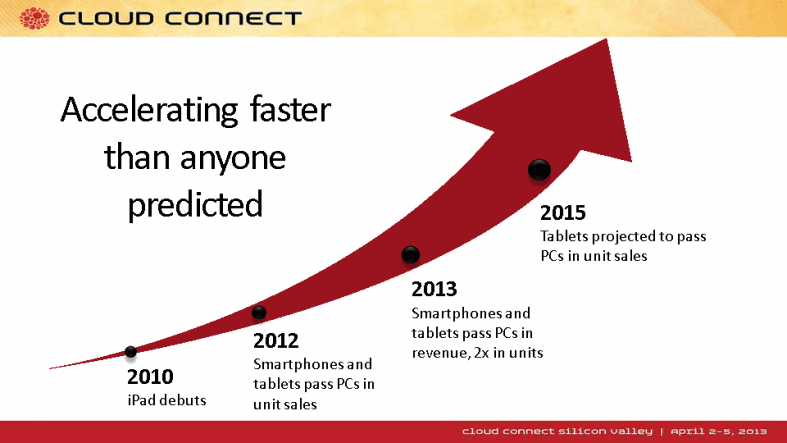
Mobile and cloud are combining to change how the underlying infrastructure of business. Mobile and cloud combine to change how applications are developed, tested and distributed. Mobile changes what features and user experience exists in applications while cloud changes where data should be located and how it will be accessed. Security and management will also change as businesses embrace mobile. Applications will be device aware, location aware and network/cloud aware. But they have to be purpose built, i.e. desktop/workstation apps won’t run on mobile computing platforms- even with 4G access. And because the demand for mobile cloud resident apps is uncertain, the mobile cloud must be very flexible in scaling up or down to accomodate the actual number of users for all the mobile apps being supported.
Going forward business processes will assume a multi-device landscape, cloud connectivity. Mobile work styles are becoming the rule rather than the exception in Enterprise IT and traditional methods of securing data behind VPNs will fall short as employees demand business tools that are as easy to use and frequently updated as the ones they use at home. Unfortunately, legal and regulatory requirements for securing data are no less stringent than they were before the mobile era. There are compliance issues with laws such as HIPAA and FINRA that apply to data sync and sharing of information/digital content.
In the future, companies will rebuild transform business applications to take advantage of a range of by using contextual data from all connected devices, including location, time of day, presence and device type. Sensors in the latest devices will also also provide contextual information such as temperature, humidity, motion, and orientation. Applications based on business critical data from connected sensors will be used by many industries, with utility, oil and gas industries leading the way. Transforming business will require businesses to use the cloud and big data processing to turn mobile data into insight in real-time.
In an excellent presentation by Jesse Lipson, Citrix VP of Data Sharing, Managing Data in the Cloud said: “VPNs are going away.They are clumsy and incovenient for mobile users.” Other reasons: there’s more IP outside of the firewall, Mobile Device Management (MDM) and simpler two factor authentication are combining to alleviate the need for VPN access. Mr Lipson also sees several new trends as a result of mobile data tsunami:
-Active Directory Integration with Single Sign On (e..g. SAML 2.0)
-2 factor authentication going away; perhaps replaced by text message authentication
-Auto Log-In from mobile devices, especially smart phones
-On premises storage alive and well due to security, compliance, convenience, and ability to access existing data stores
-“Open-in…” enable another application to open in the application being run
-Device control via MDM software deployed on all enterprise owned mobile devices
-Other mobile devices, especially laptops are getting more attention for security and control
In the end, enterprise control of mobile devices, data and apps is a balancing act between corporate compliance and security vs employee convenience and productivity (see illustration below). Each organization must decide how to chose the necessary tools, methods and procesures to ensure that both objectives are met.
2013 Cloud Connect Part II is at:
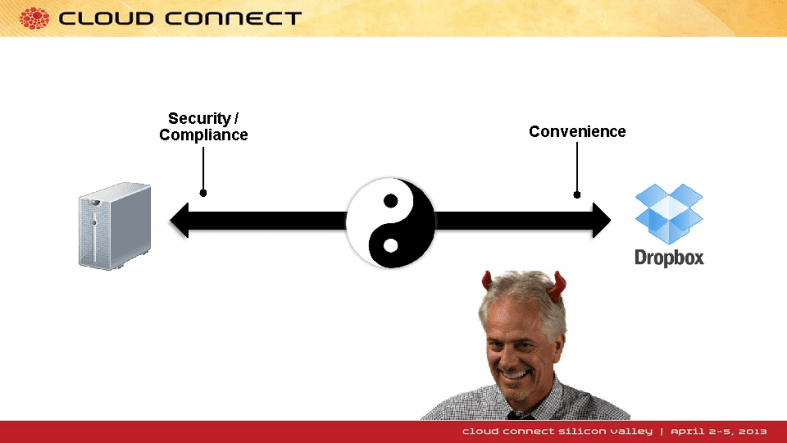
M2M Market Opportunities, Challenges, Strategies, Industry Verticals and Forecasts
Introduction:
Signals & Systems Telecom (SNS Telecom; http://www.snstelecom.com/) has just released a report on the Machine-to-Machine (M2M) communications market. The report presents an in-depth assessment of the global wireless M2M market. In addition to covering the business case, the challenges, the industry’s roadmap, value chain analysis, deployment case studies, and the vertical market ecosystem, vendor service/product strategies and strategic recommendations, the report also presents comprehensive forecasts for the wireless M2M market from 2013 till 2018, including an individual assessment of the following submarkets: Network Connectivity, Application Services, Embedded Cellular M2M Modules, Network Security, Connected Device Platforms (CDP), Application Platforms (Application Enablement Platforms, AEP and Application Development Platforms, ADP), Integration Services and Enabling Technologies, across six regions.
Also provided are network connectivity and application service revenue forecasts for the following 6 vertical market segments: Utilities & Smart Grid, Automotive & Transportation, Logistics, Public Safety, Security & Surveillance, Retail & Vending and Healthcare. Historical figures are also provided for 2011 and 2012.
Overview:
Despite its low ARPU, the wireless M2M market has become a key focus of many mobile network operators as their traditional voice and data markets become saturated. Likewise, government and regulatory initiatives such as the EU initiatives to have a smart meter penetration level of 80% by 2020 and the mandatory inclusion of automotive safety systems such as eCall in all new car models, have also helped to drive overall wireless M2M connections and revenue.
Consequently we expect the wireless M2M market to account for nearly $136 billion in revenues by the end of 2018, following a CAGR of 23% during the five year period between 2013 and 2018. Eyeing this lucrative opportunity, vendors and service providers across the highly fragmented M2M value chain have become increasing innovative in their strategies and technology offerings which have given rise to a number of submarkets such as M2M Network Security, Connected Device Platforms (CDP) and M2M Application Platforms.
Key Findings:
* The wireless M2M market will account for nearly $136 billion in annual revenues by the end of 2018, following a CAGR of 23% during the five year period between 2013 and 2018
* At present, the M2M value chain is highly fragmented with module OEMs, hardware solution providers, application platform providers, device platform providers, and mobile network operators and aggregators/MVNOs all investing across multiple segments of the value chain, whilst still maintaining a key focus on a specific portion
* Signals and Systems Telecom expects the value chain to consolidate in the future, with a smaller number of larger and profitable competitors across the M2M value chain
* The growing presence of wireless M2M solutions within the sensitive critical infrastructure industry is having a profound impact on M2M network security services, a market estimated to reach nearly $1 billion in annual spending by the end of 2018
* Driven by demands for device management, cloud based data analytics and diagnostic tools, M2M software platforms (including CDP, AEP and ADP) are expected to account for $6 billion in annual spending by the end of 2018
Key Questions Answered:
* What are the key market drivers and challenges in the wireless M2M ecosystem?
* What are the key applications of M2M across industry verticals?
* How is the M2M value chain structured, how will it evolve overtime, and what will be its impact on key vertical segments of the market?
* What opportunities does M2M technology offer to mobile network operators and other players involved in the value chain?
* What strategies should mobile network operators/MVNOs, module vendors, hardware solution providers, software platform providers and other players adopt to capitalize on the M2M opportunity?
* How big is the M2M opportunity, and how much revenue will the industry generate in 2018?
* What will be the installed base of wireless M2M connections in 2018?
* Which geographical regions and industry verticals offer the greatest growth potential for M2M services?
* What is the vendor market share embedded cellular M2M modules, how many units will ship in 2018 and how will declining ASPs impact the sales revenue?
* How will embedded cellular M2M module shipments vary by air interface technology overtime, and will LTE take a lead in 2018?
* What is the network connectivity and application service ARPU for M2M services, and how will this vary overtime for each industry vertical?
* How big is the market for M2M network security and software platforms?
For more information, including report pricing, please contact Andy Silva: [email protected]
Other SNS Telecom reports are listed at: http://www.snstelecom.com/reports-library
Another recently released M2M report was by Research & Markets:
M2M: The Next Billion Mobile Connections – Essential Analysis of the Growing Wireless M2M Industry
In that report, Parks Associates analysts examine the growing wireless M2M industry and highlight opportunities in this space for mobile service providers in the U.S. and globally. The report includes a comprehensive overview of the complex M2M ecosystem, profiles of leading M2M vendors, and analysis of carriers’ M2M strategies. The report also illuminates important trends in key verticals and provides a forecast of carrier-enabled device connections through 2016.
“Mobile service providers are facing declining revenue from traditional voice and SMS services and mobile data traffic growth that outpaces growth in data revenues,” said Jennifer Kent, research analyst, Parks Associates. “In search of new opportunities, mobile service providers are expanding their presence in the Machine-to-Machine (M2M) space. Widespread consumer and enterprise adoption of broadband Internet service, wireless routers, and devices with mobile connectivity means the ingredients are there for the M2M market to take off. Plus, mobile network operators have unique assets that position them to take advantage of the growing M2M market.”
http://www.researchandmarkets.com/research/5p8vdb/m2m_the_next
Sprint in Deal with U.S. Law Enforcement to Restrict China Gear, especially from Huawei
Seeking to address national security concerns, Sprint Nextel and SoftBank, its Japanese suitor, are expected to enter an agreement with American law enforcement officials that will restrict the combined company’s ability to pick suppliers for its telecommunications equipment and systems, government officials said on Thursday.
The agreement would allow national security officials to monitor changes to the company’s system of routers, servers and switches, among other equipment and processes, the officials said. It would also let them keep a close watch on the extent to which Sprint and SoftBank use equipment from Chinese manufacturers, particularly Huawei Technologies. The government officials spoke about the possible agreement on the condition of anonymity because negotiations are continuing. SoftBank, one of Japan’s biggest cellphone companies, is offering to buy majority control of Sprint for $20.1 billion.
While common to most technology investments in the United States by foreign companies, such agreements have come into sharper focus recently because of accusations by United States government officials of espionage by foreign countries.
SoftBank and Sprint have already assured members of Congress that they will not integrate equipment made by Huawei into Sprint’s United States systems and will replace Huawei equipment in Clearwire’s network. Clearwire is a discount cellphone firm Sprint is seeking to buy.
Masayoshi Son, the Chairman and CEO of SoftBank; Daniel Hesse, CEO of Sprint; and Erik Prusch, CEO of Clearwire, jointly sought to reassure United States officials that the merged company would take the steps necessary to ensure that its networks would not endanger United States communications networks.
Representative Mike Rogers, Republican of Michigan and chairman of the House Permanent Select Committee on Intelligence, said on Thursday that he also met this month with the company executives, who promised him that they would not use equipment from Huawei.
“I expect them to make the same assurances before any approval of the deal” by national security officials, Mr. Rogers said. “I am pleased with their mitigation plans but will continue to look for opportunities to improve the government’s existing authorities to thoroughly review all the national security aspects of proposed transactions.”
A recent report by the intelligence committee identified Huawei and the ZTE Corporation, another Chinese equipment provider, as possible security risks. The report cited the companies’ potential ties to Chinese intelligence or military services.
References:
http://arstechnica.com/security/2013/03/sprint-softbank-to-shun-chinese-networking-equipment/
Technologies that will offer higher quality viewing experience & enable new OTT services
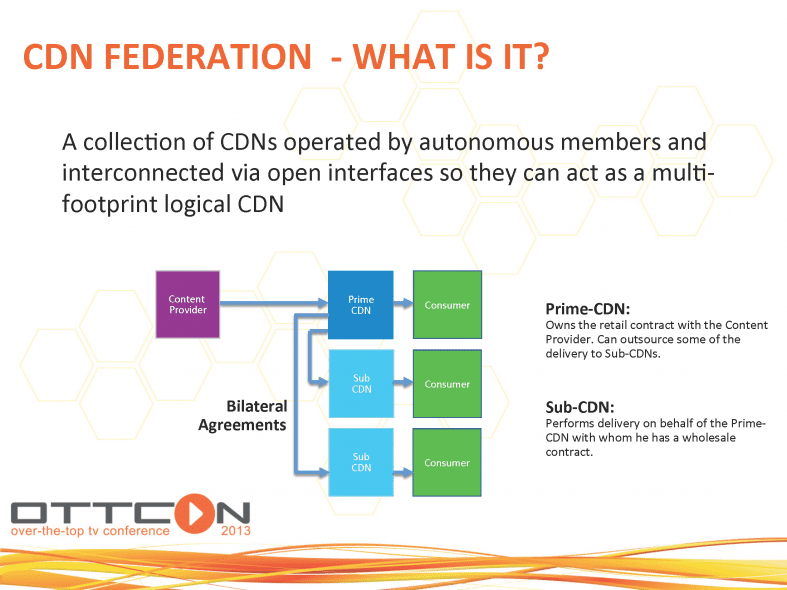
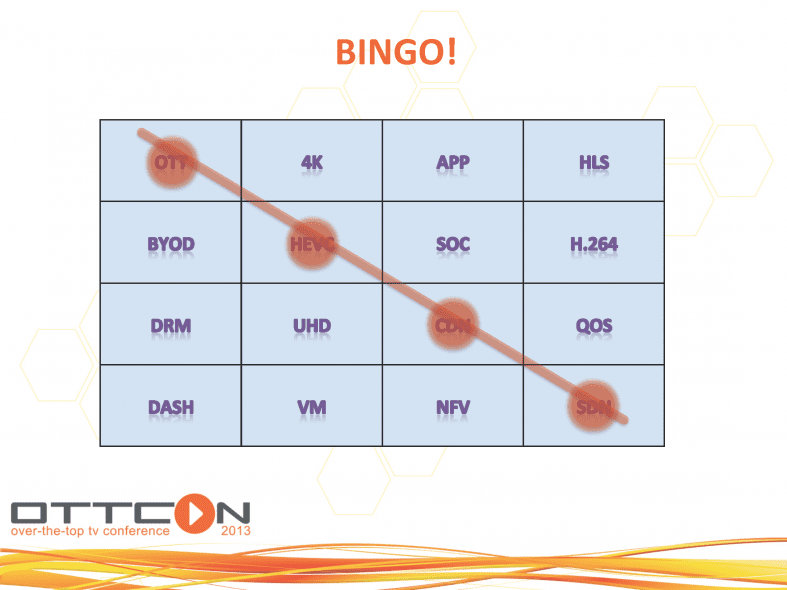
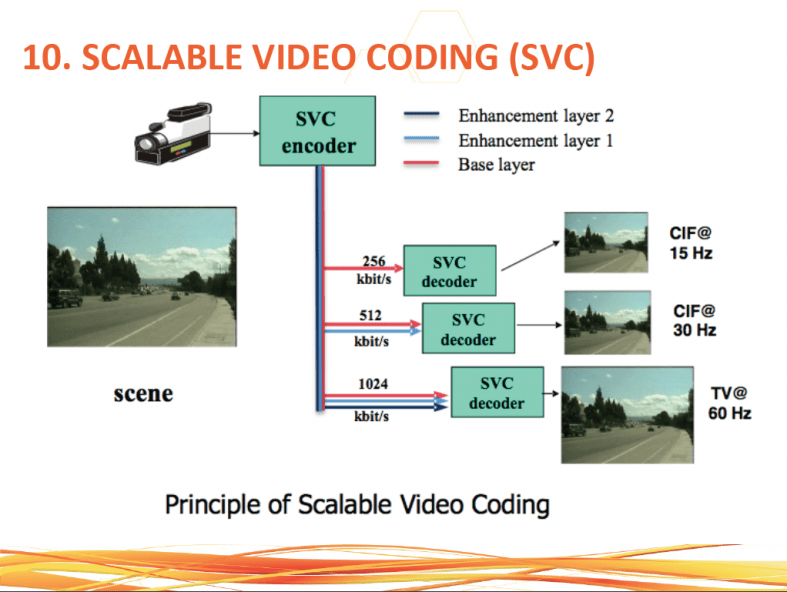
Oracle Acquires Tekelec to Pursue Telco Market: Manage, Control & Analyze IP Traffic
Less than two months after buying Acme Packet, Oracle has announced that it has agreed to acquire Tekelec, a leading provider of network signaling, policy control, and subscriber data management solutions for communications networks. The company has also been an innovator in IP traffic shaping.
Tekelec specializes in critical elements of the modern IP carrier network where the networking and IT software operations converge. This is the area where Oracle sees its opportunity to expand in the telco market – by bringing its data center and IT systems to telecos and taking on incumbent telco vendors like Ericsson.
Financial terms of the deal were not disclosed. Tekelec has been considered a potential acquisition target since it went private in November 2011. It was then acquired by a group led by private equity firm Siris Capital for $761m, a deal which many believed undervalued the company. Tekelec made a name for itself in the 1980s and 1990s by specializing in test equipment and then converting to a VoIP software company.
Last month, Oracle paid $1.7bn for Acme Packet, which specializes in VoIP and IP traffic equipment, notably session border controllers. We analyzed that transaction in this article: https://techblog.comsoc.org/2013/02/04/oracle-buys-acme-packet-for-2-1-billion-to-provide-converged-systems-solution
It appears that Oracle is building a group of software technologies which help network operators control and manage IP traffic and analyze it in detail, in order to impose policies such as offload or premium charging – increasing the ability to monetize the exploding traffic. In particular, it is now a major force in signalling, taking players like F5, which acquired Diameter specialist Traffix over a year ago. With the Tekelec and Acme Packet acquisitions, Oracle will be in a better position to compete with Cisco Systems, which has recently bought policy management firm BroadHop.
“In an increasingly mobile and social world, customer experience is about optimizing network performance and personalizing services based on what engages, moves, and inspires people,” said Ron de Lange, president and CEO, Tekelec, in a statement. “Together with Oracle, we expect to accelerate the pace of service innovation by helping service providers transform the way they manage and monetize the explosive growth in signaling and data traffic on their networks.”
“Oracle has in the past partnered to provide these capabilities, but by bringing them in house it will have more opportunity
to shape the roadmap and combine the capabilities in a more tightly-coupled solution,” wrote Ovum principal analyst Dana Cooperson in a research note. “Expect Oracle’s telecom focused competitors (Alcatel-Lucent, Huawei, Ericsson) and its IT-focused competitors (HP, SAP, SAS Institute) to do more strategic soul searching and, as their financial situation allows, to pursue acquisitions of their own.”
“As connected devices and applications become ubiquitous, intelligent network and service control technologies are required to enable service providers to efficiently deploy all-IP networks, and deliver and monetize innovative communication services,” said Bhaskar Gorti, general manager of Oracle Communications, in a statement.
In addition to its software products, Tekelec owns hundreds of patents and applications in the communications space. This is an area that Oracle has not hesitated to explore in the courtroom, and given the billion-dollar-plus sums involved in some patent battles, this could have bumped up the pricetag for Tekelec somewhat higher.
References:
http://www.oracle.com/us/corporate/acquisitions/tekelec/index.html
http://www.rethink-wireless.com/2013/03/26/oracle-bolsters-telco-assault-tekelec-buy.htm
FBR: SDN’s impact on the networks deployed by service providers and large enterprises
FBR’s research leads them to believe that the next generation of network and datacenter hardware will blur the boundaries between routing, switching, and computing, providing a single hardware platform on which network and computing functions will be delivered through software applications.
• Drive power efficiencies from a total platform perspective.
• Lower the overall datacenter footprint.
• Seek to eliminate redundant or nonessential hardware and components.
• Commoditize hardware, thus driving value into “select” software and semiconductors. This new hardware attempts to eliminate the need for custom, purpose-built hardware (example: routers, switches), instead replacing this with a common but versatile computing/switching platform.
• Drive the commoditization of hardware through the scaled use of non-branded component based hardware solutions in distributed datacenter architectures (i.e., white box servers, switches provided by reference designs from the Open Compute Project [OCP]).
• Attempt to replace ASICs with “open” merchant silicon and/or drive advanced functionality into general purpose CPUs (i.e., OpenFlow enables the transfer of the control plane into the CPU).
• Seek to utilize and optimize “open source” software and hardware alternatives (OpenFlow, OpenStack, OpenCompute hardware reference designs).
• Increase infrastructure flexibility through a software approach (example: network function virtualization).
Source: BIG “switches:” little SERVERS–FBR’s Holistic View of the Coming Datacenter, written by FBR Technology, Media & Telecom research group
Subject: SDN: New Approach to Networking
Subject: The Open Networking Foundation
http://www.ewh.ieee.org/r6/scv/comsoc/ComSoc_2012_Presentations.php
Wireless Infrastructure Market and Carrier WiFi integration with cellular networks
The wireless network infrastructure market is currently in a phase of transition as mobile network operators seek to address increasing mobile traffic demands amidst global economic uncertainties. This paradigm shift is bringing new challenges and opportunities to wireless infrastructure vendors.
In 2011, global 2G , 3G and 4G wireless infrastructure revenues were $45.9 billion. Signals and Systems Telecom (http://www.snstelecom.com/) estimates that these revenues increased 8 percent year on year (YOY) reaching $49.7 billion by end of 2012, primarily driven by LTE investments. However, between 2012 and 2017, the market is expected to shrink to $48.6 billion. That’s because of the decline in operator spending on 2G and 3G network infrastructure, network management and related software.
Although, the new wave of 4G-LTE macrocell Radio Access Network (RAN) and core network investments will not be able to compensate the overall declines in 2G and 3G equipment sales, operators are expected to significantly increase their spending in the evolving small cell and carrier WiFi equipment market. Small cell and WiFi offload equipment will represent a market of $5.4 billion in 2017. Consequently the small cell and WiFi offload market segment is attracting considerable attention from both established vendors as well as startups which solely focus on the small cell market.
However, carrier WiFi will NOT be supported by all operators. For example, Sprint and Verizon Wireless have no definitive plans to operate carrier WIFi networks. Market research firm Informa #1 Trend for 2013 was that Wi-Fi will become a victim of its own success
“There will be a shift in operator sentiment away from public Wi-Fi as it becomes evident that the growing availability of free-to-end-user Wi-Fi devalues the mobile-broadband business model. Mobile operators will respond by articulating the value of their cellular networks better, but others not affected by this trend will double down on their public Wi-Fi investments to continue to propel the deployment and monetization of Wi-Fi.”
Based on it’s WiFi/cellular integration demo at the 2013 Mobile World Congress, Telefonica d’Espagne seems to be 100% committed to Carrier WiFi. And so is ATT&T based on their Wayport acquisition in 2008. AT&T might be in the best position to provide access to a worldwide Wi-Fi network. In that scenario, customers would pay a set amount (maybe $5 or $10 a month) for that capability. The fact that no one has a fixed monopoly on Wi-Fi makes this a difficult trend for mobile operators to control.
Republic Wireless, a mobile virtual network operator, has created a service that primarily relies on Wi-Fi for connectivity and defaults back to the cell network. Republic sells its service for $19 a month, far less than what people pay carriers. Thus, if carriers seek to monetize their Wi-Fi offerings they are going to have to figure out how to create a service that’s better than what most users cobble together on their own.
IEEE ComSocSCV had a great technical meeting debating the pros and cons of Carrier WiFi along with the new features and functions of IEEE 802.11ac. Presentos will be posted at the archive section of the Chapter’s web site: http://comsocscv.org
Bell Labs (ALU) narrows its R&D focus to be more product-oriented & realize "near term gains"
What’s left of Bell Laboratories is focusing on software product development on behalf of its parent company, Alcatel-Lucent. “We want to still be the innovation arm of Alcatel-Lucent (ALU) that continues to amaze and surprise people. But I think in order to do that we do have to change somewhat,” said Bell Labs’ Gee Rittenhouse. He added, “As the industry moves toward dynamic networks, distributed systems, Bell Labs also has to move toward those directions.”
Last month, ALU appointed Rittenhouse as the new leader of the nearly 90-year-old Bell Labs, known for inventing the first transistor, along with a whole host of other technological innovations and discoveries. During his tenure, Rittenhouse plans to steer Bell Labs more toward software products related to networking and cloud computing.
Increasingly, Bell Labs is collaborating with outside partners to solve major technological problems facing the IT industry. One such effort is the GreenTouch Consortium, which is focused on dramatically reducing the power needs of today’s telecommunication networks. Bell Labs and Alctatel-Lucent’s rivals like Huawei and ZTE, among others, are members of the group.
To bring more products to the market, Rittenhouse said Bell Labs will choose long-term projects that can result in near-term gains for the market. Although he declined to reveal specific projects at Bell Labs, he pointed to “immersive communication” as one area the research division has heavily invested time in. This involves examining what makes face-to-face conversations genuine, and how that experience can be replicated over long-distance communication.
“So research in applications, multimedia is just as important as research in physics,” Rittenhouse said. “Because if you are only in math, physics, optical, you are missing this big sea change,” he added.
http://www.cio.com/article/730268/Bell_Labs_Aims_At_Getting_More_Products_to_Market_Faster
http://www.computerworld.com/s/article/9237625/Bell_Labs_hopes_to_get_more_products_to_market_faster
AW Comment: The days of pure research are long gone. Today, companies have a very short time horizon and must get product to market quickly to maintain a competitive edge. This is especially true in the telecom equipment business, where low cost Chinese vendors Huawei and ZTE, have taken considerable market share from the previous incumbents and forced some (e.g. Nortel) out of business.
Here are a few articles on Bell Labs as the standard for innovation (may no longer be true):
http://www.physicstoday.org/daily_edition/science_and_the_media/is_legendary_bell_labs_the_us_s_gold_standard_for_innovation
http://viodi.com/2012/04/06/computer-history-museum-event-summary-the-idea-factory-bell-labs-and-the-great-age-of-american-innovation/
http://www3.alcatel-lucent.com/wps/portal/!ut/p/kcxml/04_Sj9SPykssy0xPLMnMz0vM0Y_QjzKLd4w3MXMBSYGYRq6m-pEoYgbxjggRX4_83FT9IH1v_QD9gtzQiHJHR0UAaOmbyQ!!/delta/base64xml/L3dJdyEvd0ZNQUFzQUMvNElVRS82X0FfNDZL
http://www.lgsinnovations.com/about-us/bell-labs
http://www.nytimes.com/2012/02/26/opinion/sunday/innovation-and-the-bell-labs-miracle.html?pagewanted=all&_r=0


